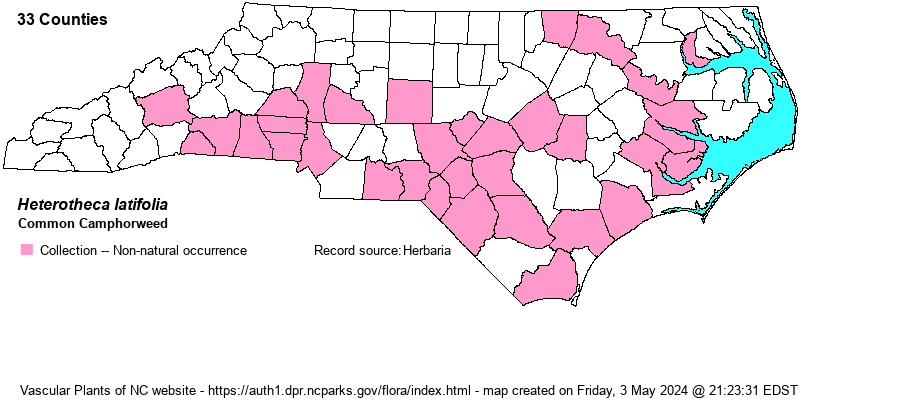| Author | Buckley | |
| Distribution | Throughout most of the Coastal Plain, Sandhills, and southern Piedmont; scarce in the southern Mountains. Seemingly absent from the northern Piedmont and most of the Mountains. The taxonomic status of H. latifolia vs. H. subaxillaris has been debated for decades. Most recently, Weakley (2020) lumps H. latifolia within H. subaxillaris, apparently based on a paper by Nesom (2020) in Phytoneuron. However, for convenience we show both taxa mapped on the H. subaxillaris page.
Native of south-central U.S. and Mexico; Weakley (2018) considers it as native eastward only to AR and LA. | |
| Abundance | Uncommon to locally frequent, except rare in the Mountains. The taxon that is often commonly seen along and near the coast is H. subaxillaris, by many considered native. | |
| Habitat | Dry sandy roadsides, railroad margins, fields, cropfields, waste places, clearings. | |
| Phenology | Flowering and fruiting August-October. | |
| Identification | Common Camphorweed is an annual or biennial, coarse, branched plant mostly 1.5-3 feet tall. The middle and upper stem leaves are rather sessile, the lower leaves with stalks; all with a camphor-like odor due to stipitate glands. The rays and disks are golden yellow. Note the non-maritime habitats (contra H. subaxillaris of maritime dunes and sand flats). Weakley (2018) indicates that Common Camphorweed is an erect plant (up to 6 feet tall), whereas the other is erect or decumbent, only to 3 feet tall at best; it also has leaves that are hirsute on both sides or scabrous above, vs. scabrous on both sides or only below for H. subaxillaris. | |
| Taxonomic Comments | Some references included this taxon within H. subaxillaris as a variety or as a subspecies. Note that Weakley (2020) lumps it completely, but without comment.
| |
| Other Common Name(s) | Usually just called as Camphorweed, but so too is H. subaxillaris, and thus both species need modifier names. Weakley (2018) uses Common Camphorweed for this species and Dune Camphorweed for the other one. | |
| State Rank | SYN | |
| Global Rank | GNR | |
| State Status | | |
| US Status | | |
| USACE-agcp | | |
| USACE-emp | | |

